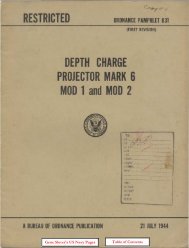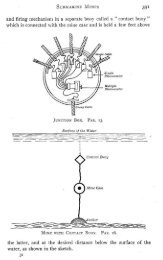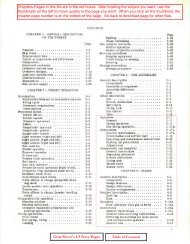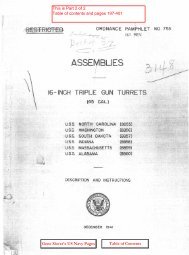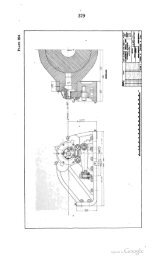Oahu's 8-inch Naval Turret Batteries 1942-1949 - Personal Page of ...
Oahu's 8-inch Naval Turret Batteries 1942-1949 - Personal Page of ...
Oahu's 8-inch Naval Turret Batteries 1942-1949 - Personal Page of ...
You also want an ePaper? Increase the reach of your titles
YUMPU automatically turns print PDFs into web optimized ePapers that Google loves.
Volume 22, Issue 1 The Coast Defense Journal <strong>Page</strong> 10<br />
The 8-<strong>inch</strong> gun-mount housings were lightly armored, only providing shelter from the weather<br />
and possibly flying splinters. As an added precaution against flying splinters, both turrets at Wilridge<br />
were bunkered. Similar bunkers were proposed for the other sites, but it is not known if these were put<br />
in place at the other three batteries.<br />
Work Orders for <strong>Batteries</strong><br />
Army engineers issued the following job and work orders for the batteries:(17)<br />
1. Brodie Camp: Job Order (J.O) 440-WW and Work Order (W.O.) 600.118-A-13.<br />
2. Salt Lake: J.O. 727-V, W.O. 600.118-H-73.0 and 600.118-A-12.0.<br />
3. Opaeula: J.O. 726-W and W.O. 600-118A-11.2.<br />
4. Wilridge: W.O. 600.118-595.<br />
Army engineers and civilian contractors worked around the clock to complete the batteries, as<br />
invasion fever ran high from the December 7, 1941, Pearl Harbor attack until mid-1943. General<br />
Emmons authorized the use <strong>of</strong> lighting during the blackout, having assigned the projects a priority just<br />
below that <strong>of</strong> airfield construction.<br />
The lightly armored turrets and splinterpro<strong>of</strong> battery commanders’ stations were the major aboveground<br />
features <strong>of</strong> the 8-<strong>inch</strong> NT batteries. All the batteries were constructed <strong>of</strong> reinforced concrete<br />
by cut and cover, with projectile and powder magazines, gaspro<strong>of</strong> plotting rooms, and bombpro<strong>of</strong><br />
generator rooms 15 to 40 feet below the surface.<br />
All 8-<strong>inch</strong> NT mounts were designed for 360° fire without interfering with each other. The batteries<br />
had a high rate <strong>of</strong> fire (12-16 rounds per battery per minute). The North Shore batteries, Brodie<br />
and Opaeula, covered the waters to the north, east, and west, and as far south as the Pearl Harbor entrance.<br />
The South Shore batteries, Salt Lake and Wiliwilinui Ridge (called Battery Wilridge), covered<br />
the waters to the south, southeast, and southwest, including the approaches to Honolulu and Pearl<br />
Harbors, and could also fire north.<br />
Walter V. Higbee, former CO <strong>of</strong> Battery Wilridge, described concentration points on land, “such<br />
as roads, bridges, etc. that we could lay fire on in case <strong>of</strong> invasion.” The battery was supplied with 8<strong>inch</strong><br />
HE projectiles for such targets, as well as AP rounds for use against cruisers. Higbee wrote that<br />
the gun crews had been trained by navy personnel and that supplies related to the guns were drawn<br />
from Pearl Harbor.(18)<br />
Fire Control Equipment<br />
It was planned to use the original fire control equipment for the batteries, which included Mk<br />
XVIII naval optical gun directors with attached Mk III Ford rangekeepers, and Mk XX directors, in<br />
conjunction with Mk 33 Bausch and Lomb rangefinders mounted in four <strong>of</strong> the turrets. However,<br />
they were replaced later in 1944 with a standard army fire control system.(19)<br />
The Mk XVIII optical gun director with the Mk III rangekeeper was the first modern director in<br />
Lexington-class aircraft carriers and Salt Lake City-class cruisers. Sights were automatically set for range<br />
and deflection by the rangekeeper, using tilting mirrors rather than the standard method <strong>of</strong> moving<br />
the telescope proper. Arma Engineering developed the system, Hannibal Ford the director and rangekeeper.(20)



